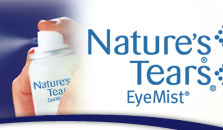©October 14, 2004
Bio-Logic Aqua Technologies
Biomedical Research/Education Division

New
Discoveries About Computer
Eye Irritation
What is it?
What to do about
it?
Computers and Your
Eyes.
It
happens to all “computer dependent” people (which is
getting to be just about everybody). You’ve been working at your computer for
hours and your eyes gradually begin bothering you. The distraction could cost
you money, productivity and, eventually, your visual health. Ophthalmologists
are encountering this problem more and more. They have named it “Computer Eye
Irritation” (or “C.E.I.”, also called “Computer Vision Syndrome” or “C.V.S.”).


Environmental
causes of CEI:
In addition to the intense light of the computer
monitor, research is discovering that several other common office conditions
may result in dry, irritated eyes:
Forced-air heating and cooling. Synthetic chemicals (plastics, paint, cleaning fluids, etc).
Insulated windows and walls. Crowding.
Fluorescent lighting. Stress.
Low indoor humidity.
Dry, irritated
eyes.
The
environmental stresses just described all result in a slight increase in
moisture (water) evaporation from the delicate TEAR FILM covering the eye’s exposed
portions. The tear film, though only about five microns (millionths of a meter)
thick, is amazingly complex. It consists of:
Lipid layer. This topmost layer is comprised of a very
thin film of fatty oil that lubricates the eyelid and slows moisture
evaporation from the lower layers.
Aqueous layer. The middle and
thickest layer contains the vast majority of the tear film’s moisture. Obviously,
this is where most moisture loss occurs. The layer also contains electrolytes,
proteins and bacteria-fighting antibodies. It provides oxygenated water to the
cornea.
 Mucin layer. This bottom layer consists of mucus that glues the tear film to the optical surface.
Mucin layer. This bottom layer consists of mucus that glues the tear film to the optical surface.
The
most physically irritating results of tear film moisture loss are an
over-concentration of electrolyte (salt) and proteins in the aqueous layer. The results are itching,
burning, eye-strain and other symptoms. Insufficient oxygen in the aqueous layer’s moisture can also cause
discomfort.
Tear film cross section
Soothing dry
irritated eyes.
Soothing
dry, irritated eyes is simple and logical: Simply
add moisture to the tear film!
In the past 110 years of medical
research, this has proved more easily said than done. Traditional formulated eyedrops can be of some benefit as a moisture sealer, but they
can be inconvenient to apply and aren’t always effective. The chemicals and
preservatives cause an allergic reaction and they may be safely applied only a
few times a day. Instead of working naturally to augment and replenish tear
film moisture, the large-drop application can flood and wash away the tear
film, including protective antibodies, replacing it with artificial chemicals.
Nature’s
Tears EyeMist.
The
best way to prevent or keep eyes moist and minimize CEI discomfort is to mist
your eyes with Nature’s Tears EyeMist whenever discomfort is felt. The unique
moisture-mist provides the correct pH balance, mineral content and osmolarity to penetrate to the tear film’s aqueous layer in just the right amount;
without flooding. Even if you continue using regular eyedrops,
they will become more effective as a moisture sealer (to help decrease moisture
film evaporation), if you apply Nature’s Tears EyeMist first. Because Nature’s
Tears EyeMist has no dosage limit, you may also apply the mist between eyedrop applications, or as a
stand-alone whenever ocular discomfort is felt.
Additional
tips on minimizing or preventing CEI:
- An eye care professional may be able to prescribe
special “computer glasses.”
- Keep a glass of water near your desk to help
humidify the air.
- Sip bottled water while you work…but pour it into
a glass before drinking.
- Make a conscious effort to blink more often
(especially if you tend to stare at the screen for long periods). Tape a
reminder to the computer if necessary.
- Several
times per hour, look around the room at objects of varying distances from
the computer.
- Take scheduled breaks away from your desk
(outdoors if possible, to help reduce stress).
- To reduce glare, position your computer so
windows are at the side of your computer rather than in front or back.
- Adjust window blinds so that sunlight is away
from your screen and eyes.
- If possible, turn off overhead lights that are
too bright. Or switch to a lower wattage bulb or a desk lamp.
- Attach a glare-blocking hood or filter to your
monitor. The can be found at most computer and office supply stores.
- Crack a window to let in humid air from the
outside. Outdoor air is free of re-circulated bacteria
and shed skin particles from co-workers, which enters via the
heating/cooling system and are dehydrating to eyes and skin.
- Set the REFRESH RATE on your monitor as high as
you can (over 85 is best). Use a flat-screen if possible. A low refresh
rate (60 or less), on a cathode ray monitor, can cause eyestrain and
headache. For Windows PC, right click on the opening screen (no programs
running), then go to “properties-settings-advanced-monitor.”
- Take long, luxuriant showers every day that allow
plenty of steam and moisture to penetrate your eyes, skin, breathing
passages and lungs.
- Every couple weeks, take a hot body bath with a
cup of Epsom salt dissolved in the bathtub water. This will benefit all
parts of your body, including the skin, the eyelids, the skin around the
eyes and the eyes.
1-800-FOR-MIST www.NaturesTears.com






